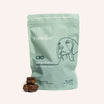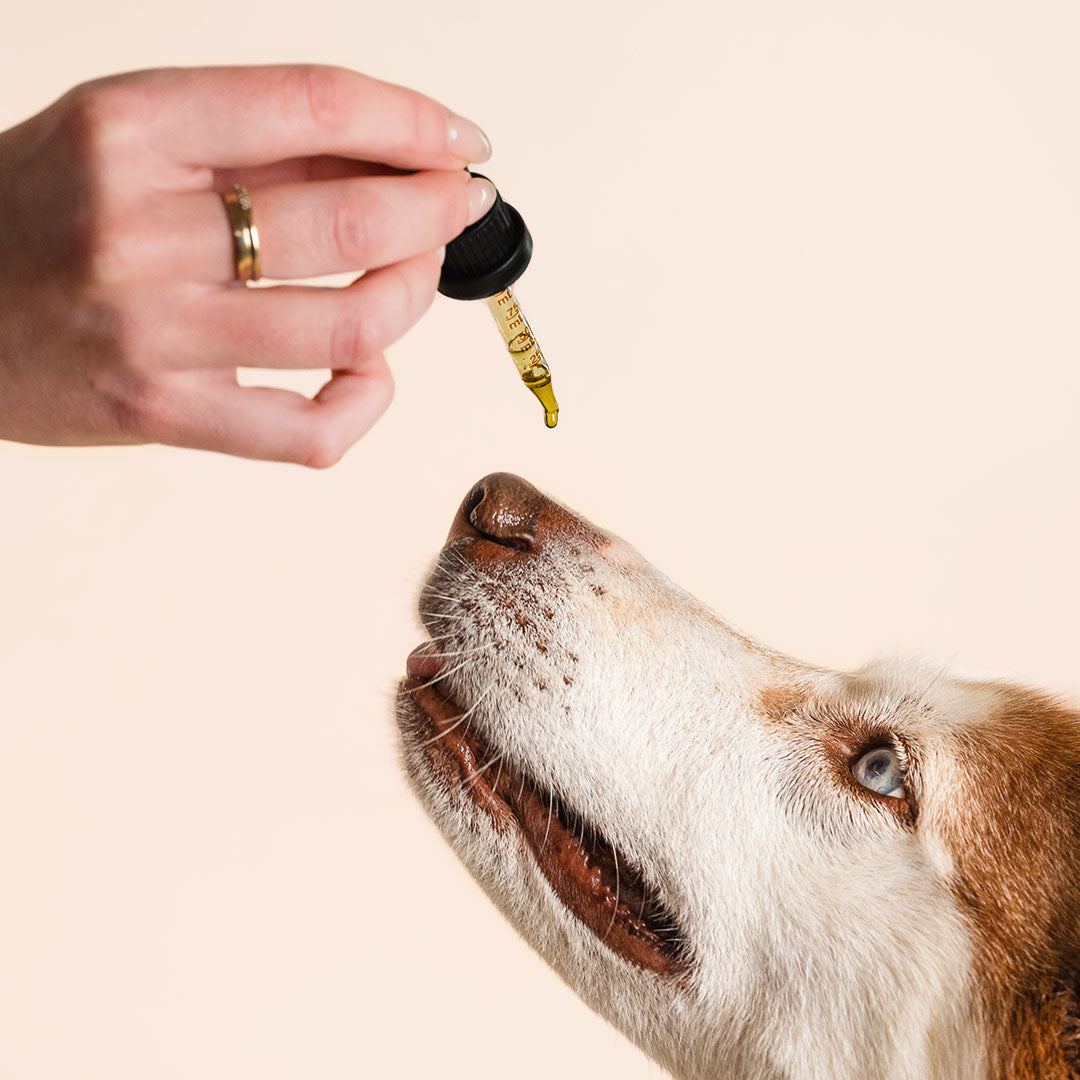It’s no surprise that witnessing your dog have a seizure is never a pleasant experience, no matter how many times you’ve seen it or how mild the episode is. At times, it can be extremely terrifying and raise a number of questions or concerns.
What are seizures? How do they happen? Will they keep happening? Are they painful? What kind of medication or treatment can I give my dog to make them stop or better yet, go away completely? These are all common questions that race through our minds when dealing with dogs and seizures. Let's take a deeper look at these questions and better yet provide some answers, more specifically let's look at if you can use CBD oil for dog seizures. To better understand seizures we first need to identify what they really are.
What Is A Seizure Or Epilepsy?
Basically, a seizure is a period of abnormal electrical brain activity. This abnormal activity can affect the whole brain or sometimes only part of it. During a seizure, your dog may demonstrate some combination of the following symptoms:
- Loss of consciousness
- Loss of muscle control
- Kicking, or pedaling movements
- Periods of twitching or stiffness
- Abnormal vocalization
- Licking and chomping
- Foaming at the mouth
- Loss of bladder and bowel control
Your dog will not return to normal immediately afterwards. During this ‘postictal’ phase, that can last minutes to days, they might be unsteady, hungry, blind, they might pace compulsively, and they could be disorientated and aggressive.
Epilepsy In Dogs
The term epilepsy simply means repeated seizures. This disorder is diagnosed by a veterinarian who will try to identify underlying causes from your pet's history and by performing diagnostic tests. This disorder involves unpredictable seizures and can cause other health problems. Dogs who have this condition will demonstrate symptoms, like the ones listed above, that are associated with abnormal electrical activity in the brain.
Now, a common and justified question is..."So, if my dog has a seizure, does that mean he or she has epilepsy?" The answer is no. Seizures can be caused by different things and can often occur only once in a pet's lifetime. We’ll go over the different causes of seizures in just a minute.
For now, let’s discuss the different types of seizures that occur, which can be categorized as generalized and focal.
Types Of Dog Seizures
Generalized Seizures
Generalized seizures are the most common types of seizures seen in dogs. These can be classified by the signs shown and include tonic, tonic-clonic (previously called grand mal), atonic, and myoclonic seizures.
They affect the whole body and both sides of the brain. They can last from a couple of seconds to a few minutes. During this type of seizure, the dog may fall, lose consciousness, and convulse. They may lose control of their bladder or bowels, salivate, foam at the mouth, chomp at the jaw, and may vocalize through barking or whining. During a generalized seizure, their breathing may become uneven.
The combination of signs seen will vary with each dog, depending on which parts of the brain are affected by the seizure. However, an individual dog will usually have seizures that look the same or very similar each time.
Tonic
The body or limbs suddenly become stiff or tense. The dog may have only a small change in awareness during a tonic seizure. Tonic seizures usually involve all or most of the brain, affecting both sides of the body and generally last less than a minute. Vocalizations may be present due to air being forced past the vocal cords. The dog may drop while having a tonic seizure.
Tonic-clonic
The first part of a tonic-clonic seizure will begin with tonic symptoms. They are then followed by the clonic segment of the seizure. During this phase, the limbs may begin to jerk rapidly accompanied by bending and relaxing at the joints.
After a few minutes, the convulsions should slow and eventually stop. During a tonic-clonic seizure, your dog may lose control of their bladder or bowel as their body relaxes. Consciousness will return slowly.
Dogs experiencing these types of seizures generally last one to three minutes. Once aware, the dog may seem confused, tired, or irritable. Please note that any tonic-clonic seizure that exceeds five minutes needs immediate medical attention.
Atonic
Part or all of the body may become limp. The head may drop, and your dog may suddenly drop to the ground. These seizures are generally short in duration, lasting less than 30 seconds.
Myoclonic
These seizures are very brief, usually less than a few seconds. There are sudden, rapid contractions of muscles producing unexpected movements. They can be mistaken for tics. These seizures can be easily overlooked because they are so brief and appear as extra normal movements.
Focal Seizures
The second is the Focal category. In these seizures, abnormal electrical activity only happens in part of the brain. Focal seizures can affect different parts of the brain and as a result, dogs can exhibit a range of signs. It is not unusual for them to lead to a generalized seizure.
If parts of the brain that control movement are affected, motor signs such as twitching on one side of the body, raising just one limb, or turning their head to a specific side will occur. These typically last only a few seconds.
Partial Seizures
If the brain region affected controls behavior, your dog might show random behaviors that can last from a few seconds to a couple of minutes. They might be hard to spot at first because the behaviors can seem slightly normal like barking at the wall.
Generally, if a dog is experiencing these types of seizures, the behavior will be the same during each one making it easier to identify when your dog is having one. In some dogs, these seizures may manifest as a brief absence. Your dog will suddenly stop during an activity. A blank look or stare will be present. They generally last less than 10 seconds.
If the focal seizure is originating in parts of the brain that control autonomic functions like urination, your dog might salivate profusely, vomit or show changes in pupil size. When doing other research, you might hear the terms "idiopathic, cluster, status epilepticus."
Cluster Seizures And Status Epilepticus
Cluster seizures are when your dog experiences 2 or more seizures in a 24-hour period. Many dogs that suffer from cluster seizures have multiple seizures within a short timeframe. Often confused with status epilepticus, during a cluster episode, your dog will have periods of consciousness between each seizure.
Unlike cluster seizures, during an episode of status epilepticus, your dog will not regain consciousness between seizures. Status epilepticus is a seizure that lasts more than 5 minutes or is a failure to regain consciousness between seizures. Both of these conditions are very dangerous and can be life-threatening, so please treat them as emergencies.
Although seizures may look scary or violent, there is generally no pain involved during the episode. There may however be moderate muscle fatigue after the seizure due to convulsions. A dog might also become slightly confused after as well.
Did you know that dogs experiencing seizures is not uncommon? According to the AKC, or American Kennel Club, owners report that as much as 5% of dogs deal with seizures on a regular basis.
Various Causes Of Seizures And Epilepsy In Dogs
Now that we’ve defined and identified the different categories and types of seizures, let’s review the causes. First, remember that if your dog has repeated seizures, their disorder is called epilepsy. Epilepsy is subdivided as structural, if an underlying brain disorder is identified, or idiopathic. Note also that if your dog is suffering seizures due to a metabolic condition such as low blood sugar, their seizures are called reactive seizures.
There are numerous causes of seizures and these are usually divided into causes that lie outside the brain (extracranial) and those that originate within the brain (intracranial). Extracranial causes include low blood sugar or calcium, liver disease, and toxins among other conditions. Intracranial causes include head trauma, brain cancer, strokes, encephalitis (inflammation of the brain) as well as conditions such as hydrocephalus.
If the onset of seizures occurs in dogs aged between 1 and 6 years, and no other cause is identified, a diagnosis of idiopathic epilepsy is made. This diagnosis means your dog has a genetic predisposition to seizures.
Numerous dog breeds are genetically more prone to seizure disorders. This list includes Beagles, Belgian Tervurens, Bernese Mountain Dogs, Collie breeds (e.g. Border Collie, Shetland Sheepdog, Rough Coated Collie), Dachshunds, English Springer Spaniels, Finnish Spitz, German Shepherds, Irish Wolfhounds, Keeshonds, Labrador Retrievers, Poodles, Saint Bernards, Shetland Sheepdogs, and Vizslas among other breeds. For some breeds of dog, the genetic cause is known and a genetic test is available. Information on such tests is available from the AKC.
While unusual, stress can be a trigger for dogs with seizures. The stress could be a result of a change in routine, getting over-excited, or even a visit to the vet. Some medications are also known to be triggers for epilepsy in some dogs, including flea and tick treatments and some prescription medications.
Outside in the yard, fertilizers, lawn treatments, other chemicals, and heavy metals such as lead have been known to trigger seizures. In the home, cigarette smoke, perfumed products, products that contain pine oil, and paint fumes have been identified as triggers for dogs with seizures. Certain foods, including caffeine, moldy cheese, and saffron and sage have also been linked to epilepsy in dogs.
What To Do When Your Dog Has A Seizure
So, what should you do when your dog has a seizure? Here are some general guidelines to a safe recovery:
Monitor Surrounding Area
The only time you should move a dog while it is having a seizure is if it is in immediate danger. An example would be if your dog drops while having a seizure in the middle of a busy street. Instead, it’s best to clear the immediate area surrounding your dog of objects that might be harmful while convulsing, like a chair or sharp-cornered object. Be mindful of sharp edges near steps or planters, too. If you have other dogs, keep them away because some dogs can become aggressive to the dog having a seizure.
Keep Track Of Time
Monitor the duration by timing the seizure. It’s useful to keep an accurate record of your dog’s seizure activity. This will prove helpful to a veterinarian during the diagnosis process. If it exceeds more than five minutes, contact your vet as soon as possible.
Comfort Your Dog
You can comfort your dog by speaking to it, but avoid contact near its mouth as they may chomp or bite down while having muscle spasms. Do not place anything in its mouth. Contrary to popular belief, there is little to no danger of your dog swallowing his or her tongue.
Have A Towel Handy
Dogs may become incontinent and involuntarily urinate or defecate. It might prove useful to have a small towel handy.
Watch For Overheating
If the seizure exceeds more than two minutes, your dog becomes at risk of overheating. Using a cool towel to lower its temperature or running cool water over its paws is recommended. If possible, move the dog indoors or seek a shaded area while recovering. Relocating to an air-conditioned room would be ideal.
What To Do After Your Dog Has A Seizure?
Immediately after a seizure, a dog will appear confused and dazed. This period, which is called the post-ictal phase, can last anywhere from a few minutes to a few hours. The dog is likely to look like they have been sedated. All the senses may appear to be dull, the dog’s reactions will be sluggish, and many dogs with seizures experience temporary blindness after an episode.
During this period it is important to supervise a dog to ensure that it doesn’t hurt itself. Your pet is going to feel frightened and disorientated so some comforting may be needed but be aware that some dogs can be unpredictable and could even bite as they recover. Be very cautious when approaching them.
Dogs will often become hungry after a seizure as well. Having food and water readily available is great practice. Supervising the dog immediately after a seizure is also important because another seizure may occur although this is not always the case.
Hopefully, if your dog has a seizure it doesn’t happen again. However, if your dog has already been diagnosed with epilepsy, let’s review the common treatment options.
Treatment Options For Dogs With Seizures
Treatment for seizures in dogs usually begins with attempting to identify the cause or the trigger of the seizure. If it is an ongoing issue, medications may be prescribed.
Currently, most veterinarians will create a care plan that involves pharmaceutical medication as a treatment for epilepsy. Medications are typically prescribed if seizures are happening more frequently than once a month. If less frequent than this, you may be asked to monitor your dog carefully and keep a seizure log that you can share with your veterinarian.
The list of medications veterinarians prescribe for epilepsy includes phenobarbital, Keppra (levetiracetam), zonisamide, and potassium bromide. Drugs like diazepam (more commonly known as Valium) or midazolam might be prescribed for emergency situations.
More recently, consumers have been asking about CBD, which is a fully natural, non-GMO, gluten-free extract from hemp. The benefits of using CBD as a treatment for seizures have not yet been approved by the FDA. As such, it should not be intended to prevent, treat, or cure any ailments or diseases. Research on this super cannabinoid is currently ongoing.
Side Effects Of Seizure Medications In Dogs
Now, although the traditional pharmaceutical drugs are effective, they do have some negative side effects and it is important to ask your veterinarian to explain them. What's also interesting is that despite their long history of use by physicians to treat seizures, not one of these drugs is FDA approved. This is an area of concern as pet owners may be unaware of the risks of these drugs.
Phenobarbital is known to cause drowsiness and your dog may become unsteady while moving if high doses have to be used. The most serious side effect is damage to the liver and in some dogs, phenobarbital has been associated with liver failure. Although a proper veterinarian will work with you to monitor liver function and blood levels of phenobarbital to avoid this problem.
Excessive hunger and thirst have also been linked to dogs taking phenobarbital as a seizure medication and unwanted weight gain can pose a real challenge to owners. In addition, phenobarbital can alter the metabolism of other drugs, particularly other anti-seizure medications, and can in very rare cases affect the bone marrow. If this occurs, phenobarbital has to be withdrawn.
Keppra has become popular because it is an extremely safe drug. While perhaps not as effective as phenobarbital it is used when possible because it is so safe. Zonisamide is also relatively safe although it has been associated with liver problems, and conditions like dry eye.
Potassium bromide is often used with phenobarbital and it can cause an increase in appetite and thirst. It is known to cause an upset stomach in some dogs, stumbling, and drowsiness at high doses. Mild cases of vomiting and bloody feces have also been reported. It also requires regular blood tests to check the potassium bromide levels in their blood.
You should always consult with your veterinarian if you think your dog’s medication or dosage amounts should be changed. Never stop giving your dog its prescribed medication, or go ‘cold turkey’. This can have an adverse reaction and instead accidentally cause a seizure. So now let’s quickly discuss CBD and CBD oil.
What Is CBD Oil?
CBD, short for Cannabidiol, is a powerful cannabinoid derived from the cannabis plant which has been used for therapeutic reasons for thousands of years. The extraction process of CBD from the cannabis plant involves using a solvent such as carbon dioxide (CO2) to pull the element from the plant. Then, the CBD is infused with a carrier oil such as hemp seed oil. It’s important to remember that CBD is not intoxicating. It is extracted from the hemp species of the cannabis family, not marijuana.
Can You Use CBD Oil For Dog Seizures?
As discussed earlier, CBD has not yet been approved for medical or supplemental use by the FDA. It is not intended to prevent, treat, or cure any ailments or diseases. As such, here are 4 properties of CBD that make it a popular choice for dog owners:
CBD Is Natural
It’s important to note that CBD oil comes from a natural source. This means that it may be a more holistic option for your dog. Taking a holistic approach for treatment means treating your dog as a whole, taking into account mental and social factors.
No Harmful Ingredients
CBD oil is also a vegan option that, if extracted properly, contains no chemicals or other harmful ingredients. As a result, your dog won’t be ingesting any potentially toxic substances.
Convenience
Another advantage of CBD oil is that it’s easy to use. You can administer the oil directly into the mouth, soak it into a treat, or mix it into a favored snack or meal.
Antioxidants
Additional benefits of using CBD are its antioxidant properties. Antioxidants are highly beneficial for dogs and humans alike, and may help promote overall wellness.
Are There Any Side Effects Of Using CBD Oil For Dogs?
Interestingly enough, it’s also important to note that there have not been any reports of severe side effects of using CBD oil for dogs. While there is still no scientific study that shows the side effects of CBD in dogs, here is what has been reported in human use; dry mouth, a slight temporary drop in blood pressure, and slight drowsiness during high dosage consumption.
How Much CBD Oil Should I Give My Dog?
So, how much CBD oil should you give your dog? The correct dose of CBD oil depends on the size of your dog. The bigger your dog is, the more CBD oil you will need to administer. More specifically, the exact dosage of CBD oil depends on the weight of your dog.
The general rule of thumb is 0.25 mg of CBD oil per pound of body weight. For example, a dog weighing 20 pounds would require a 5 mg dose, whereas a larger dog weighing 60 pounds would require a 15 mg dose.
For stronger doses, the general rule of thumb is 0.5 mg of CBD oil per 1 pound of bodyweight. This means that a dog weighing 20 pounds would require a 10 mg dose, whereas a larger dog weighing 60 pounds would require a 30 mg dose. For a more detailed guide on the proper dosage of CBD for your dog’s seizures, please visit our CBD oil dosage chart. We hope this article has helped you better understand what seizures are and has provided you with a little more knowledge when it comes to treatment options.
#1 Vet Recommended CBD Oil for Dogs
As always, we invite you to browse HolistaPet's #1 vet-recommended and dog-friendly CBD products for more information. Our all-natural CBD oil is 100% organic and includes only the highest quality non-GMO ingredients.
Looking for a treat instead? Our CBD Dog Treats come in three different varieties, each with a unique blend of superfoods suited for different needs. Remember, all of our CBD products for dogs are gluten-free, grain-free, and vegan so you can ensure that your dog is consuming only the best of nature's offerings.
Thanks for visiting and please don’t forget to visit us regularly for more up-to-date info on CBD and pet health news! We wish you and your furry companion health and happiness always.








![Probiotics For Dogs [Soft Chews] - HolistaPet](http://www.holistapet.com/cdn/shop/files/Probiotic-Infographic-1_472d7a29-e30c-435a-9638-1365d8c3a9f9.jpg?v=1725384841&width=104)















![CBD Oil For Dog Seizures : Know Everything About It [Update]](http://www.holistapet.com/cdn/shop/articles/280_520x500_520x500_79690ae2-56db-4971-a8b0-8b4318df2840.jpg?v=1738826230&width=1500)
![CBD vs CBG [Breaking Down Their Differences & Similarities]](http://www.holistapet.com/cdn/shop/articles/286_62633391-a106-45b4-9590-3a93f1cdc210.jpg?v=1738278396&width=500)









Leave a comment
All comments are moderated before being published.
This site is protected by hCaptcha and the hCaptcha Privacy Policy and Terms of Service apply.